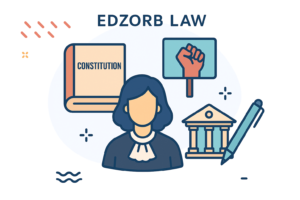Imagine stepping into a courtroom, uncertain of how your case will unfold. The outcome hinges on many factors, but one of the most powerful influences is the principle of judicial precedents. Judicial precedents provide a roadmap for the law, where past decisions help shape and guide future ones.
For law students, judiciary aspirants, or anyone interested in understanding how courts function, grasping the importance of judicial precedents is essential.
What Are Judicial Precedents?
A judicial precedent is essentially a past court decision that serves as a guide for future cases with similar circumstances. It acts as a standard for judges to follow, ensuring consistency in the legal system.
When a case is presented with similar facts, the court looks at earlier rulings to help determine the outcome, maintaining fairness and stability in the law. This concept is at the heart of common law systems like India and the UK. It ensures:
- Consistency
- Fairness
- Predictability
The Two Sides of a Precedent

According to legal scholar Dias, a precedent includes not only the decision itself but also the reasoning behind it. It serves as a guiding principle for future cases, ensuring that similar facts and legal issues are handled in the same way.
Precedents provide a framework for the courts to maintain consistency, while allowing room for the law to evolve as societal norms and circumstances change over time. This approach upholds the integrity of the legal system by balancing stability with adaptability.
- Concrete Decision – The final ruling applicable to the specific case.
- Abstract Principle – The broader rule derived from that ruling, which can be used in future cases.
Types of Precedents (Salmond’s Classification)
Authoritative Precedents
- Must be followed.
- Come from higher courts.
- Legally binding.
Persuasive Precedents
- Not binding, but influential.
- May include:
- Foreign judgments (e.g., UK, US)
- Dissenting opinions
- Advisory rulings (like from the Privy Council)
Evolution of Precedents: From Custom to Case Law
- Medieval England: Judges enforced customary practices
- 18th Century: Lord Mansfield pushed for consistent legal application
- 19th Century: Lord Tenterden formalized the idea of binding precedent
- 20th Century: Holdsworth emphasized the balance between history and modernity
The takeaway? Precedents aren’t rigid, they’re legal memory banks, evolving with time. While they provide a foundation for consistency, they also adapt to reflect changing societal values, new legal insights, and emerging issues.
As a result, precedents help ensure that the law remains relevant and responsive, allowing it to grow with the needs of society while maintaining its core principles.
Court Hierarchies & Precedent Power
In the UK:
In the UK, judicial precedents follow a clear hierarchy. The House of Lords, now the Supreme Court, sets precedents that bind all lower courts, ensuring uniformity in the legal system. The Court of Appeal binds lower courts but has the power to overrule itself in exceptional circumstances.
In India:
In India, the Supreme Court holds the highest authority in shaping legal precedents. Its decisions bind all courts across the country, ensuring uniformity in the interpretation and application of the law.
🧠 Ratio Decidendi vs Obiter Dicta
Ratio Decidendi
The core legal principle behind a decision serves as the foundational reasoning that dictates its outcome. This principle sets a precedent, becoming binding in future cases with similar facts, which ensures consistency and stability in the application of the law.
Obiter Dicta
While extra comments, observations, or side remarks are not legally binding, they can still hold persuasive value, particularly when they are well-argued or relevant to the case.
Per Incuriam: When a Judgment Gets It Wrong

A decision is said to be per incuriam when it’s made in ignorance of a relevant law or binding precedent. Such decisions are considered flawed and may not serve as valid precedents in future cases.
- Ignoring a relevant law or precedent
- In error of jurisdiction or procedure
These are not binding and can be safely disregarded in future rulings.
Stare Decisis: Stability vs Flexibility
Stare decisis promotes consistency, stability, and predictability in the legal system by ensuring that similar cases are decided in a similar manner. It encourages respect for established legal principles, fostering trust in the judicial process and ensuring fairness in legal outcomes.
- Legal certainty
- Guidance for lower courts
- Equal treatment
But it’s not a cage. Courts can and do deviate when:
- New social realities emerge
- Past decisions are morally or legally flawed
- Constitutional values demand innovation
The Power of Dissenting Opinions
Famous dissents have shaped history by offering alternative legal reasoning that challenges the majority opinion. Over time, these dissenting views have often influenced significant legal changes and societal shifts.
- Justice H.R. Khanna’s dissent in ADM Jabalpur laid the foundation for future rulings on personal liberty.
- Justice Chandrachud’s dissent in Sabarimala helped reframe the conversation on gender rights.
Dissent is a voice of legal foresight, sometimes a whisper today becomes the rule tomorrow.
When Precedents Lose Power
A precedent may lose its force when it is overruled by a higher court, often due to changes in societal values or legal principles. Additionally, a precedent may lose relevance if it is found to be per incuriam, meaning it was decided in ignorance of an important law or binding precedent.
- Reversed by a higher court
- Refused due to policy change
- Distinguished due to different facts
- Ignored statute
- Sub Silentio (decided without addressing a crucial point)
Why Precedents Matter (Especially for Judiciary Aspirants!)
They are not just dusty rulings from the past they’re:
- Answer-enhancers for case-based questions
- Concept builders for applying law in practical scenarios
Knowing how and when a precedent binds a court can elevate your legal analysis.
Level-Up Your Judiciary Prep with Edzorb Law!
At Edzorb Law, we bring precedents to life with:
- Flashcards on landmark cases
- Visual notes on doctrines like Ratio, Obiter, Stare Decisis
- Mock test questions on judgment principles
- Bite-sized lessons for anytime revision
Don’t just memorize; Master the art of precedent with Edzorb.

 Podcast
Podcast








 Features
Features






